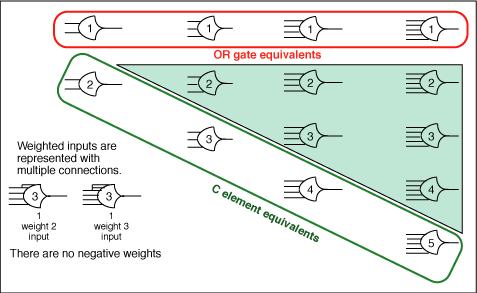2NCL
as a Threshold Logic
NULL
means not-data, so the NULL value cannot be considered
in resolving data value sets. Since each input
to a gate expresses only one data value there
can be no combinations of different data values
as in Boolean logic, there can only be combinations
of the single DATA value. The only discriminable
property available when combining DATA values
at the input to a gate is how many DATA values
are presented. Therefore, 2NCL gates can be naturally
viewed as a threshold logic comprising discrete
M of N threshold gates with hysteresis behavior.
Figure
13 illustrates the graphical representation
and the behavior of a 3 of 5 gate. The number
inside the gate indicates the threshold of the
gate M and the input connections indicate the
N. Thin lines are NULL. Wide red lines are DATA.
Beginning in a NULL state with all inputs NULL
and asserting a NULL result value, the gate will
not assert a DATA result value until its input
data set is complete, which in this case is three
data values. Then the gate will maintain the DATA
value until all of its input values are NULL at
which time it will transition to a NULL result
value.
Figure
13. Hysteresis behavior of 2NCL gate.

Figure
8 shows the 2NCL family of logic gates noting
correspondences to familiar gate functions. Weighted
inputs are shown as multiply connected inputs.
There are no negatively weighted inputs. Each
gate expresses the completeness criterion for
both data in relation to NULL and for NULL in
relation to data. Each gate and any combination
of gates expresses the universal NULL function.
Notice that there is no equivalent to the Boolean
AND gate and there is no inverter.
Figure
14. 2NCL family of logic gates.

There
is not as strong an intersection of 2NCL with
classic threshold logic synthesis [references:
8, 9,
10] as might
be expected because neither hysteresis behavior
nor completeness relationships were considered.
2NCL in Relation to Boolean Logic
Figure
15 shows the 2NCL equivalents to the Boolean
gate functions. Each gate equivalent has two dual-rail
inputs and one dual-rail output. The inversion
has one dual-rail input and one dual-rail output.
Figure
15. 2NCL mappings for Boolean functions.

Unateness,
Monotonicity and Hazard Freeness
The
first thing to note is that variable inversion
does not involve signal path inversion. It is
just a relabeling of the signal paths of the variable.
Any single variable function including the complement
function for any size variable is just a mapping
of each input value to an output value and in
the multi-path representation this can be expressed
by simply relabeling the paths according to the
mapping. There is no sense to inverting a signal
path in a 2NCL combinational expression. All 2NCL
combinational expressions are strictly unate at
the signal level. During a DATA wavefront there
are only transitions from NULL to DATA. There
are no transitions from DATA to NULL. During a
NULL wavefront there are only transitions from
DATA to NULL. There are no transitions from NULL
to DATA.
Sub-Variable
Expressivity
The
next thing to note is that the mapping is no longer
gate for gate. The Boolean gate equivalent functions
are multi 2NCL gate expressions. While Boolean
gates are dealing with inputs and outputs that
are whole variables, 2NCL gates are dealing with
inputs and outputs that are individual values
of variables. For instance the 2 of 2 gate in
the OR expression of Figure 15
has as input the zero value path from each input
variable but does not consider the 1 value path
from either variable. In this sense 2NCL might
be called a sub variable logic. One significant
consequence of this is that completeness criterion
and completeness of participation are lost at
the signal path level and at the logic gate level.
Completeness
at the Variable Level
While
completeness criterion and completeness of participation
have been lost at the signal path and gate level,
these completenesses can be maintained at the
variable level with units of expression that have
whole variables as input and output. The 2NCL
expressions of Figure 15
do not transition their output variables from
NULL to DATA until the input variables are completely
DATA (one DATA value per variable) and then do
not transition their output variables to NULL
until the input variables are completely NULL.
The variable level boundaries of each expression
unit are a logically determined completeness boundaries
that express the completeness criterion at the
variable level for the expression unit as a whole.
These 2NCL expression units are functionally identical
to 3NCL gates. They can be directly substituted
for Boolean gates as in Figure
6 or can be otherwise composed to form 2NCL
combinational expressions that, as a whole, expresses
the completeness criterion and completeness of
participation.
|